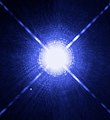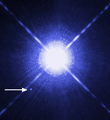Fasciculus:Sirius A and B Hubble photo.jpg
Sirius_A_and_B_Hubble_photo.jpg (369 × 403 elementa imaginalia, magnitudo fasciculi: 179 chiliocteti, typus MIME: image/jpeg)
Historia fasciculi
Presso die vel tempore fasciculum videbis, sicut tunc temporis apparuit.
| Dies/Tempus | Minutio | Dimensiones | Usor | Sententia | |
|---|---|---|---|---|---|
| recentissima | 09:11, 19 Octobris 2019 |  | 369 × 403 (179 chiliocteti) | BevinKacon | Reverted to version as of 19:39, 25 August 2010 (UTC) actual size from source |
| 06:26, 22 Ianuarii 2016 |  | 2 209 × 2 410 (1.43 megaocteti) | PlanetUser | higher resolution (modified from http://www.spacetelescope.org/static/archives/images/pl_original/heic0516a.tif) | |
| 19:39, 25 Augusti 2010 |  | 369 × 403 (179 chiliocteti) | LobStoR | progressive JPEG generated from .TIFF at quality setting 100 | |
| 22:06, 28 Augusti 2009 |  | 369 × 403 (143 chiliocteti) | Tryphon | Reverted to version as of 12:42, 25 December 2005: original size; anything bigger is just blown-up from this image. | |
| 18:34, 12 Decembris 2007 |  | 1 280 × 1 398 (160 chiliocteti) | DENker | higher quality | |
| 12:42, 25 Decembris 2005 |  | 369 × 403 (143 chiliocteti) | Superborsuk | The image of Sirius A and white dwarf Sirius B taken by Hubble Space Telescope. Source: http://hubblesite.org/newscenter/newsdesk/archive/releases/2005/36/image/a |
Nexus ad fasciculum
Ad hunc fasciculum nectit:
Usus fasciculi per inceptus Vicimediorum
Quae incepta Vici fasciculo utuntur:
- Usus in af.wikipedia.org
- Usus in ar.wikipedia.org
- نجم
- Mu المجمرة
- نجم ثنائي
- قزم أبيض
- قالب:بذرة نجم
- الشعرى اليمانية
- رأس الجاثي
- الرجل الجاثية
- ركبة الجاثي الشمالية
- ركبة الجاثي الجنوبية
- المعصم (نجم)
- المرفق (نجم)
- غليزا 229
- نجم مزدوج
- بنات نعش الكبرى
- كتلة شمسية
- نجم المليك
- نظام نجمي
- منخر الأسد
- الصرفة (نجم)
- ظهر الأسد
- الخرت (نجم)
- رأس الأسد الشمالي
- القائد (نجم)
- المئزر (نجم)
- المراق (نجم)
- الضفيرة (نجم)
- إتا الأسد
- وولف 359
- الفخذة (نجم)
- المغرز (نجم)
- نجم أزرق شارد
- سديم دمبل
- سديم الحلقة
- مسييه 55
- جليزا 1214
- منازل القمر
- إلكترا (نجم)
- ستروب (نجم)
- مايا (نجم)
- أطلس (نجم)
- ويكيبيديا:مشروع ويكي فلك/قوالب
- الفرق (نجم)
- آخر النهر (نجم)
- الذراع الأيمن (نجم)
- الكرسي (نجم)
- مقدم يد الحواء (نجم)
- الغراب (نجم)
View more global usage of this file.




